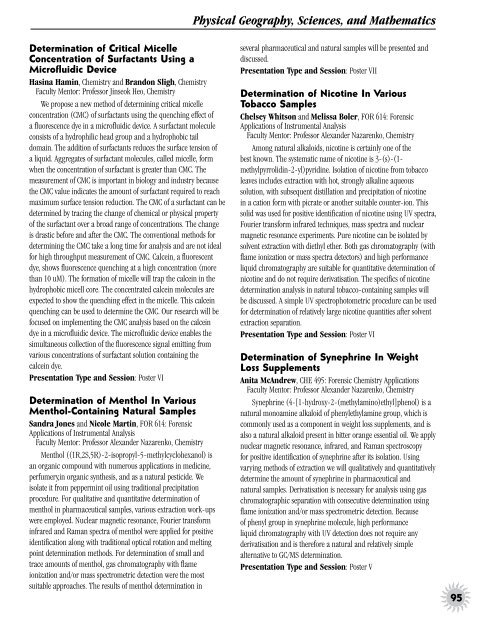Arts - Buffalo State College
Arts - Buffalo State College
Arts - Buffalo State College
You also want an ePaper? Increase the reach of your titles
YUMPU automatically turns print PDFs into web optimized ePapers that Google loves.
Determination of Critical Micelle<br />
Concentration of Surfactants Using a<br />
Microfluidic Device<br />
Hasina Hamin, Chemistry and Brandon Sligh, Chemistry<br />
Faculty Mentor: Professor Jinseok Heo, Chemistry<br />
We propose a new method of determining critical micelle<br />
concentration (CMC) of surfactants using the quenching effect of<br />
a fluorescence dye in a microfluidic device. A surfactant molecule<br />
consists of a hydrophilic head group and a hydrophobic tail<br />
domain. The addition of surfactants reduces the surface tension of<br />
a liquid. Aggregates of surfactant molecules, called micelle, form<br />
when the concentration of surfactant is greater than CMC. The<br />
measurement of CMC is important in biology and industry because<br />
the CMC value indicates the amount of surfactant required to reach<br />
maximum surface tension reduction. The CMC of a surfactant can be<br />
determined by tracing the change of chemical or physical property<br />
of the surfactant over a broad range of concentrations. The change<br />
is drastic before and after the CMC. The conventional methods for<br />
determining the CMC take a long time for analysis and are not ideal<br />
for high throughput measurement of CMC. Calcein, a fluorescent<br />
dye, shows fluorescence quenching at a high concentration (more<br />
than 10 uM). The formation of micelle will trap the calcein in the<br />
hydrophobic micell core. The concentrated calcein molecules are<br />
expected to show the quenching effect in the micelle. This calcein<br />
quenching can be used to determine the CMC. Our research will be<br />
focused on implementing the CMC analysis based on the calcein<br />
dye in a microfluidic device. The microfluidic device enables the<br />
simultaneous collection of the fluorescence signal emitting from<br />
various concentrations of surfactant solution containing the<br />
calcein dye.<br />
Presentation Type and Session: Poster VI<br />
Determination of Menthol In Various<br />
Menthol-Containing Natural Samples<br />
Sandra Jones and Nicole Martin, FOR 614: Forensic<br />
Applications of Instrumental Analysis<br />
Faculty Mentor: Professor Alexander Nazarenko, Chemistry<br />
Menthol ((1R,2S,5R)-2-isopropyl-5-methylcyclohexanol) is<br />
an organic compound with numerous applications in medicine,<br />
perfumery,in organic synthesis, and as a natural pesticide. We<br />
isolate it from peppermint oil using traditional precipitation<br />
procedure. For qualitative and quantitative determination of<br />
menthol in pharmaceutical samples, various extraction work-ups<br />
were employed. Nuclear magnetic resonance, Fourier transform<br />
infrared and Raman spectra of menthol were applied for positive<br />
identification along with traditional optical rotation and melting<br />
point determination methods. For determination of small and<br />
trace amounts of menthol, gas chromatography with flame<br />
ionization and/or mass spectrometric detection were the most<br />
suitable approaches. The results of menthol determination in<br />
Physical Geography, Sciences, and Mathematics<br />
several pharmaceutical and natural samples will be presented and<br />
discussed.<br />
Presentation Type and Session: Poster VII<br />
Determination of Nicotine In Various<br />
Tobacco Samples<br />
Chelsey Whitson and Melissa Boler, FOR 614: Forensic<br />
Applications of Instrumental Analysis<br />
Faculty Mentor: Professor Alexander Nazarenko, Chemistry<br />
Among natural alkaloids, nicotine is certainly one of the<br />
best known. The systematic name of nicotine is 3-(s)-(1methylpyrrolidin-2-yl)pyridine.<br />
Isolation of nicotine from tobacco<br />
leaves includes extraction with hot, strongly alkaline aqueous<br />
solution, with subsequent distillation and precipitation of nicotine<br />
in a cation form with picrate or another suitable counter-ion. This<br />
solid was used for positive identification of nicotine using UV spectra,<br />
Fourier transform infrared techniques, mass spectra and nuclear<br />
magnetic resonance experiments. Pure nicotine can be isolated by<br />
solvent extraction with diethyl ether. Both gas chromatography (with<br />
flame ionization or mass spectra detectors) and high performance<br />
liquid chromatography are suitable for quantitative determination of<br />
nicotine and do not require derivatisation. The specifics of nicotine<br />
determination analysis in natural tobacco-containing samples will<br />
be discussed. A simple UV spectrophotometric procedure can be used<br />
for determination of relatively large nicotine quantities after solvent<br />
extraction separation.<br />
Presentation Type and Session: Poster VI<br />
Determination of Synephrine In Weight<br />
Loss Supplements<br />
Anita McAndrew, CHE 495: Forensic Chemistry Applications<br />
Faculty Mentor: Professor Alexander Nazarenko, Chemistry<br />
Synephrine (4-[1-hydroxy-2-(methylamino)ethyl]phenol) is a<br />
natural monoamine alkaloid of phenylethylamine group, which is<br />
commonly used as a component in weight loss supplements, and is<br />
also a natural alkaloid present in bitter orange essential oil. We apply<br />
nuclear magnetic resonance, infrared, and Raman spectroscopy<br />
for positive identification of synephrine after its isolation. Using<br />
varying methods of extraction we will qualitatively and quantitatively<br />
determine the amount of synephrine in pharmaceutical and<br />
natural samples. Derivatisation is necessary for analysis using gas<br />
chromatographic separation with consecutive determination using<br />
flame ionization and/or mass spectrometric detection. Because<br />
of phenyl group in synephrine molecule, high performance<br />
liquid chromatography with UV detection does not require any<br />
derivatisation and is therefore a natural and relatively simple<br />
alternative to GC/MS determination.<br />
Presentation Type and Session: Poster V<br />
95












